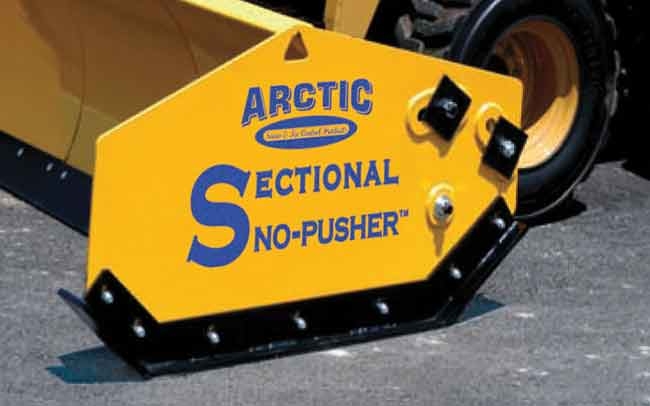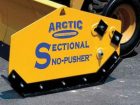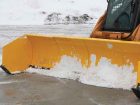
Features
Profiles
Falling for maintenance
October 13, 2016 By Randy Strait
 All pushers have wear shoes that should be inspected and replaced if severely worn. Newer “drop-and-go” hitch designs permit the shoes to “float” rather than drag during operation as well as ensure even wear on both shoes for longer life.
All pushers have wear shoes that should be inspected and replaced if severely worn. Newer “drop-and-go” hitch designs permit the shoes to “float” rather than drag during operation as well as ensure even wear on both shoes for longer life. Many homeowners, managers and customers start grumbling around this time of year because summer is officially over and they know that the next things to fall from above might not be crisp autumn leaves. While others might dread the shrinking daylight and sinking temperatures, snow and ice contractors greet this time by ensuring that their snow pusher is action-ready as soon as the first flakes drop from the sky. These contractors know that completing any remaining maintenance or equipment checks during this season reduces the risk of losing money in the next season.
Although most pushers require minimal maintenance, they’ll need some attention after several months of storage. The pusher could probably use some cleaning, especially if it sat outside all summer. Common wear-and-tear items might need replacing. But completing routine maintenance should keep that servicing downtime to a minimum.
Repelling rust
The only things that should be turning orange and brittle this season should be the leaves, so make sure the pusher is clean and corrosion-free. Summer can be hard on a pusher as dust, dirt and other debris accumulates. This can be especially tough if it wasn’t power washed at the end of the season, meaning all of last year’s salt and excess debris still clings to the pusher.
Before this season’s first storm, use a power washer to remove dirt, dust and salt.
Always take time to look at the key components on each pusher. For example, if an operator has a pusher that features moving and forgiving parts, he or she should apply a standard penetrant to pivot points, springs and joints. The same is true for edges, fasteners, and nuts and bolts to prevent rusting.
After cleaning the pusher, a detailed inspection can alert the operator to any issues. Again, because each type of pusher is built differently, tailor the inspection to suit the equipment. For more information, always consult the manfacturer’s website for online resources such as instructional videos and manuals.
Eyes open for wear and tear
Properly maintaining the pusher defends it against premature wear and diminished performance. Fortunately, pushers are fairly easy to care for and service. If a contractor needs a repair or part replacement, most of the maintenance is relatively quick and easy to complete. In fact, most technicians can service the pusher in fewer than 30 minutes.
Every pusher features either a rubber or steel cutting edge that needs inspecting and, if necessary, replacing. Rubber edges tend to have an 80 per cent shorter service life than that of steel, thus requiring more frequent maintenance and replacement. Regardless of the type of edge, replacement does come at a cost. The size of the edge and the time required for replacement can quickly increase servicing costs. Pushers that feature sectional moldboard designs minimize time and expense by allowing technicians to replace shorter, individual segments as needed.
These sectional designs typically feature 32-inch independent moldboard pieces, each mounted on the pusher’s mainframe with a mounting block. These blocks — a critical safety component — withstand a lot of pressure and impact with little damage and can last more than five years. Give the blocks a quick inspection and, if they show cracks or damage, replace them to ensure safe and proper operation. Also, ensure bolts are tight and the blocks are firmly secured to the pusher.
Inspect wear shoes prior to the start of the season and replace if severely worn. Wear can occur quickly and unevenly with standard hitch designs. Understandably, timing is critical when it’s 3 a.m. and a lot needs clearing, which means operators might not take time for the necessary adjustments. Drop-and-go hitches address that issue by self-adjusting to the pavement, ensuring even wear on both shoes for longer life and fewer replacements. These designs allow the shoes to float rather than drag during operation, further extending life. Regardless of the type of hitch, a quick check ensures the wear shoes are in proper working order.
After checking the major components, there are still several smaller parts that impact the overall performance of the pusher. Constant movement of the centre and outer springs can lead to breaks or stress points. Carefully inspect those areas and replace the spring if any part of it or the pin is broken or appears weakened due to corrosion. Finally, check that all cotter pins, nuts and bolts are intact, and tighten any that may be loose.
Read the owner’s manual for specific maintenance on individual makes and models of pushers to ensure a thorough inspection. In addition, this pre-season inspection is a great opportunity to take inventory and order any parts that mechanics might need for the upcoming season. Being proactive with inventory management will ensure unforeseen issues won’t freeze snow contractors in their tracks.
Keep checking
Carrying routine maintenance practices through the winter benefits the contractor in several ways. Besides protecting the investment and increasing the longevity of the pusher, preventative maintenance throughout the year is among the best ways to reduce off-season work.
As many contractors know, most equipment manufacturers base maintenance intervals on mileage, fuel consumption, service hours or time. But just as snow is unpredictable, maintenance intervals need to be flexible to accommodate each event and season. For example, standard guidelines may specify that some parts need monthly replacing. However, if the month has been unusually brutal with day after day of consecutive use, this interval may shorten considerably. Always use common sense when scheduling inspections, and simply replace any parts that look worn.
While simple maintenance will go a long way in extending the life of a pusher, proper operation also has a significant impact. Never shake the pusher or hit it on the pavement to remove snow. That violent jarring can add stress to joints and components, especially in frigid weather.
Also, remember that a sectional pusher doesn’t operate the same as a bulldozer when stacking snow. Proper stacking requires the carrier to lift the pusher as the machine engages the snow pile. If a the pusher is not lifted at the same rate of advance, the operator will notice each section being forced back toward the frame in rapid succession. This causes premature wear on the blocks and moldboard that can lead to significant damage. Pushers can stack snow endlessly but operators must use them properly to avoid maintenance downtime.
Lastly, proper positioning greatly affects the pusher’s longevity, so avoid too much forward or down pressure. Mentioned earlier, certain manufacturers offer special drop-and-go hitches to aid in positioning. They help take the guesswork out by automatically adjusting to the pavement grade.
Letting customers know that snow pushers are ready to take on the season might make them groan at the realization that winter is around the corner. However, completing preventative maintenance reduces the risk of downtime while clearing a parking lot as well as extends the life of the pusher, keeping the customer and the contractor happy. Best yet, that maintenenace might only cost as little as $5 for a can of penetrant and an hour to thoroughly look over the machine. Plus it gives contractors the excuse to check the weather just one more time.
Randy Strait is president of Arctic Snow and Ice Products.
Print this page

